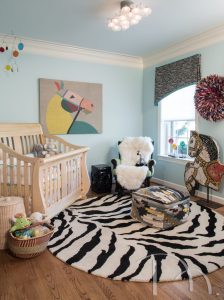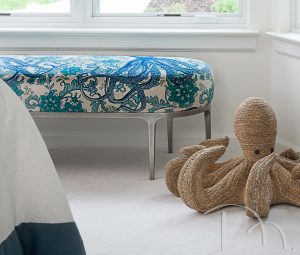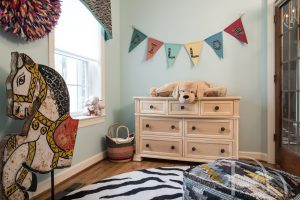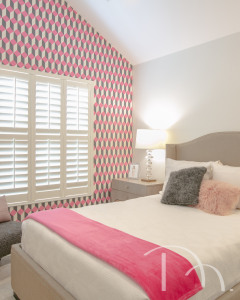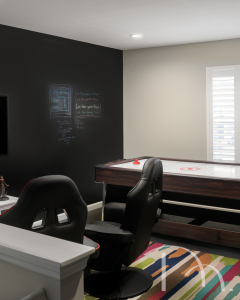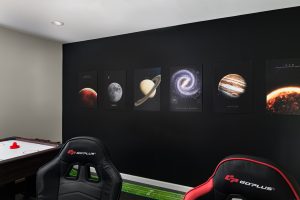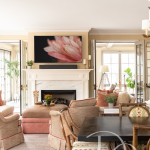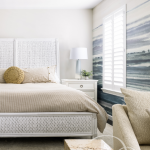Are you designing a space for your child but don’t want to redo it every few years? Whether it’s a bedroom, playroom, study area, or even a shared family space, creating a kid-friendly environment that grows with them is all about smart furniture choices, adaptable design, and functional storage. From nurseries to tween hangouts, here’s how to design spaces that evolve with your child—without sacrificing style, and keeping your sanity intact!
________________________________________________________________________
This nursery has plenty of eye candy to engage your baby while in the crib or nursing. The horse theme might have staying power past babyhood. Photo by Anne Matheis
________________________________________________________________________
1. Invest in Timeless, High-Quality Furniture That Adapts
There are two trains of thought regarding furniture for kids. One is “buy cheap, buy often,” where you opt for inexpensive furniture and replace it as your child grows. The other is to invest in timeless, high-quality pieces that adapt over the years.
I discuss both options with my clients and can run with either approach, but here, we’re going to focus on the benefits of investing in well-made, multifunctional pieces that transition from toddler to teen.
Best Furniture for Spaces That Grow with Kids:
- Convertible cribs that transition into toddler beds and eventually full-sized beds
- Adjustable desks and ergonomic chairs that accommodate growing children
- Classic dressers, bookcases, and storage benches that provide long-term solutions
- Modular seating like floor cushions or sectionals that can be rearranged as kids get older
Stick to neutral furniture in quality materials like solid wood to ensure it never looks outdated and blends seamlessly into your home’s overall aesthetic.
________________________________________________________________________
A sturdy bench can easily be recovered as your child outgrows the seaside theme and the woven grass octopus can be repurposed in a guest bedroom or at your Florida home. Photo by Karen Palmer
________________________________________________________________________
2. Design Multi-Use Play and Study Areas
As kids grow, their activities shift from imaginative play to schoolwork and hobbies. Designing flexible, multi-use areas allows the space to evolve without major renovations.
Ideas for a Playroom or Study Area That Grows with Your Child:
For younger kids:
- A cozy reading nook with floor cushions and a small bookshelf
- A low activity table for arts, crafts, and hands-on learning
- Open floor space for movement-based play
For older kids:
- A dedicated study area with proper lighting and storage
- A bulletin board or dry-erase wall for organization and creativity
- Lounge-style seating for socializing, reading, or relaxing
A well-planned layout ensures these spaces stay relevant through different stages of childhood.
________________________________________________________________________
Large colorful baskets are a great place for kids to store small toys. Pale blue walls and a colorful name banner will last throughout childhood and into the teen years. Photo by Anne Matheis
________________________________________________________________________
3. Choose a Neutral Base & Use Décor for Personality
Want to add color and personality to a kid’s space without committing to a full makeover every few years? Keep walls and foundational pieces neutral and bring in personality through bedding, rugs, and accessories.
Kid-Friendly Color Ideas That Age Well:
- Soft grays, warm whites, or muted blues and greens as a base
- Peel-and-stick wall decals or murals for easy updates
- A chalkboard or magnetic wall for a creative, interactive touch
This approach makes it easy to refresh the space as their tastes change—without the hassle of repainting or buying all new furniture.
________________________________________________________________________
This bright pink wallpaper has lasted from nursery to the teen years, with just a few pieces of furniture changing with the times. Photo by Suzy Gorman
________________________________________________________________________
4. Smart Storage Solutions: Keep Clutter Under Control
Children accumulate a lot of belongings, so smart storage is essential for maintaining an organized home. Whether it’s a bedroom, playroom, or shared living area, a well-thought-out system ensures everything has a place.
Top Storage Ideas for Kid-Friendly Spaces:
- Built-in shelving for books, toys, and collectibles
- Under-bed storage with rolling bins or drawers
- Closet systems with adjustable rods and shelving
- Labeled baskets and cubbies for easy organization
- Storage ottomans or benches in shared living spaces to keep toys contained
Clear bins are especially helpful because if kids can’t see it, they often forget it exists!
________________________________________________________________________
A small loft area was the perfect spot for a gaming room. A game station with gaming chairs and a chalkboard wall for keeping score, along with a foosball table that converts to two other games, will keep all ages happy. Photo by Karen Palmer
________________________________________________________________________
5. Create Flexible Family Spaces
In homes where kids’ activities spill beyond their bedrooms, shared spaces need to be just as adaptable.
How to Make Shared Spaces Kid-Friendly Yet Stylish:
- Use modular furniture like nesting tables or stackable stools for flexibility
- Opt for durable fabrics and materials (performance fabrics, washable rugs)
- Incorporate hidden storage for toys and games in common areas
- Create zones within open-concept spaces (a reading corner, a gaming area, etc.)
A well-balanced space allows kids to be part of family activities while maintaining a polished, grown-up aesthetic.
________________________________________________________________________
A black, deep space wall with vibrant photos of the planets, sun and moon will stand the test of time and growth of the family. A putting green on the floor brings you back to earth. Photo by Karen Palmer
________________________________________________________________________
6. Personalize the Space—Without Making Permanent Changes
A child’s environment should reflect their personality, but that doesn’t mean it needs a complete redesign every few years.
Easy Ways to Personalize Kid-Friendly Spaces:
- Gallery walls with framed artwork or favorite photos
- Removable wallpaper or decals for quick theme updates
- Monogrammed décor or marquee letters for a custom touch
- Color-blocked or geometric accent walls for a stylish but flexible look
By incorporating personalized elements in small, changeable ways, the space can evolve effortlessly with their interests.
________________________________________________________________________
Bonus: 3 Mistakes to Avoid When Designing for Kids
1.Buying trendy furniture that won’t last – Invest in quality basics and add fun through accessories.
2.Neglecting storage – Kids’ spaces need far more storage than you might expect.
3.Over-theming the room – Instead of painting a room to match a favorite character, use bedding, pillows, and wall art to keep the theme flexible. When they get tired of Pokemon and replace him with Spiderman the room is primed for the change.
_______________________________________________________________________
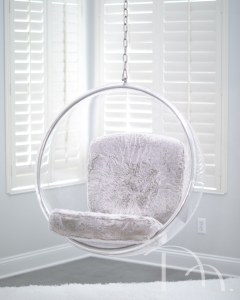
A hanging bubble chair is always fun, no matter what your age. Photo by Suzy Gorman
_______________________________________________________________________
Final Thoughts: The Key to Spaces That Last
Designing kid-friendly spaces that grow with them doesn’t mean sacrificing fun—it’s about making smart choices from the start. By investing in timeless furniture, flexible storage, and easy-to-update décor, you’ll create a home that adapts effortlessly from childhood through the teenage years.
_______________________________________________________________________
_______________________________________________________________________
Looking for expert design help? Let’s create a space your child will love now—and for years to come.
Follow us for weekly design inspiration.
Check our socials for all things Marcia Moore Design.
